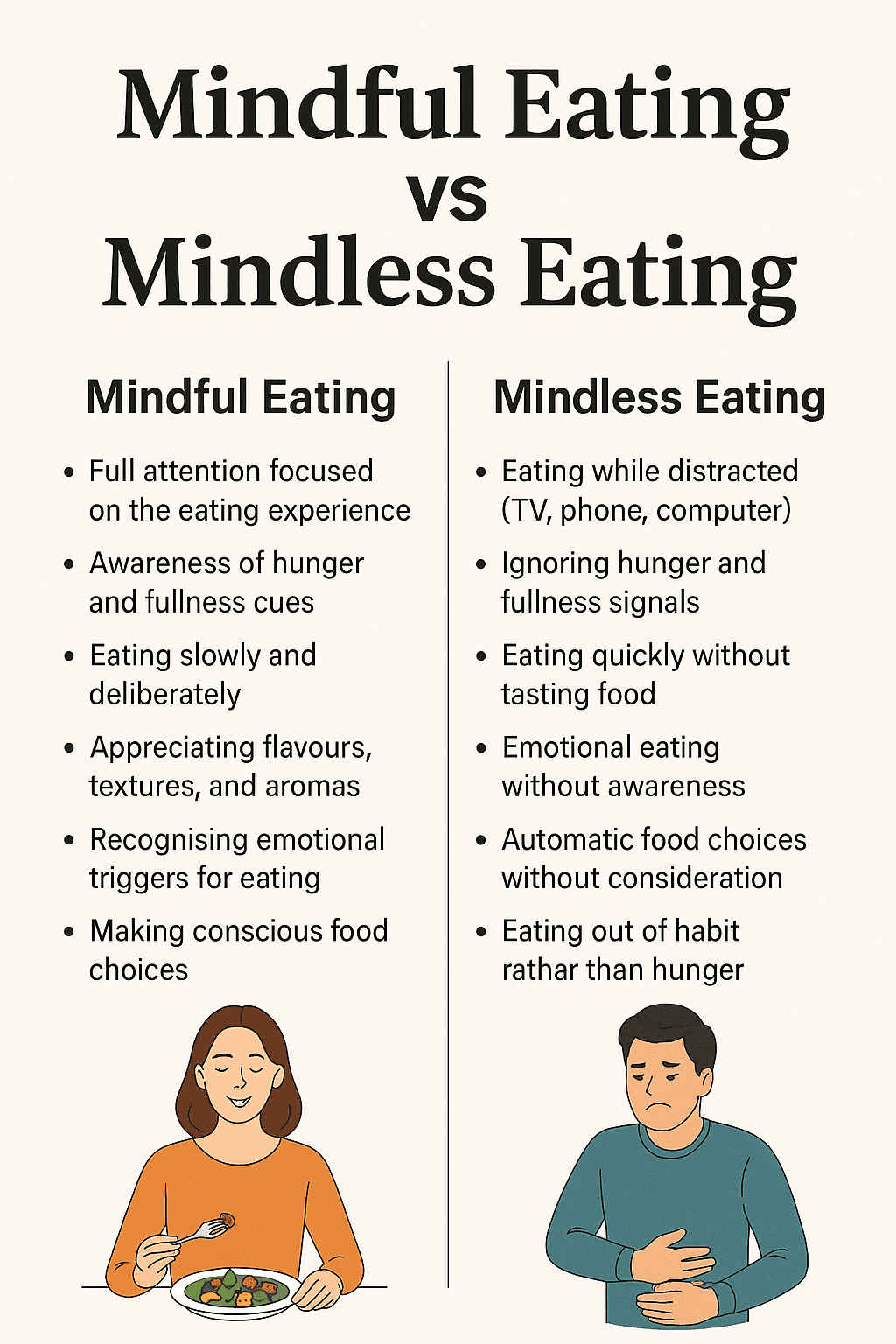
Do you remember the last meal you ate, or were you scrolling while chewing?
Mindful eating is a powerful practice that transforms how we approach food, moving away from rushed, distracted meals toward a deeper appreciation of every bite.
Let’s understand why you should adopt mindful eating as part of your healthy lifestyle.
What is Mindful Eating?
Mindful eating is the practice of bringing full attention to the experience of eating and drinking. It involves being present in the moment, observing our thoughts and feelings about food without judgment, and truly experiencing the taste, texture, and satisfaction that comes from nourishing our bodies.
Unlike restrictive diets that focus on "good" or "bad" foods, mindful eating emphasises awareness of hunger and fullness cues, emotional triggers, and the sensory experience of eating.
This practice stems from mindfulness meditation principles and encourages us to slow down and reconnect with our body's natural wisdom about food.
Mindful Eating vs. Mindless Eating
Understanding the difference between mindful and mindless eating is crucial for developing healthier habits:

Benefits of Mindful Eating
The benefits of mindful eating extend far beyond weight loss. This practice offers numerous advantages for both physical and mental health:
Physical Benefits:
Improved digestion and nutrient absorption
Better portion control naturally
Reduced bloating and digestive discomfort
Enhanced satisfaction with smaller portions
Stabilised blood sugar levels
Reduced risk of overeating
Mental and Emotional Benefits:
Decreased stress around food choices
- Improved relationship with food through mood-boosting foods
Reduced emotional eating patterns
Enhanced self-awareness and body connection
Greater food satisfaction and enjoyment
Increased mindfulness in other life areas
How to Practice Mindful Eating: Step-by-Step Guide
Learning how to eat mindfully requires practice and patience. Here's a comprehensive guide to get you started:
Step 1: Reflect Before You Eat

Before reaching for food, pause and ask yourself: ‘Am I truly hungry, or am I eating for another reason?’
Check-in with your body to assess physical hunger versus emotional needs. Rate your hunger on a scale of 1-10, with 1 being extremely hungry and 10 being uncomfortably full.
Aim to eat when you're around 3-4 on this scale.
Step 2: Create a Calm Eating Environment

Designate a peaceful space for meals, free from distractions like television, phones, or work materials.
Set the table properly, use real plates and utensils, and create an atmosphere that honours the act of nourishing your body.
This environmental shift signals to your brain that eating is important and deserves attention.
Step 3: Serve Out Your Food Mindfully

Take time to plate your food thoughtfully, appreciating the colours, textures, and arrangement, using healthy eating on a budget principles to select nutrient-dense ingredients.
Notice the visual appeal of your meal and express gratitude for the nourishment you're about to receive. This practice helps you become more aware of portion sizes and food choices.
Step 4: Engage All Your Senses

Before taking your first bite, observe your food using all five senses. Notice the colours, shapes, and presentation.
Smell the aromas and appreciate how they make you feel. Listen to any sounds the food makes. Feel the temperature and texture.
This sensory engagement enhances the eating experience and promotes satisfaction.
Step 5: Eat Slowly and Chew Thoroughly

Take smaller bites and chew each one thoroughly, aiming for 20-30 chews per bite. This allows your digestive system to work more efficiently and gives your brain time to register fullness.
Put your utensils down between bites to naturally slow your eating pace.
Step 6: Pause Between Bites

Regular pauses during meals help you assess your hunger and fullness levels. These moments of awareness prevent overeating and help you recognise when you've had enough.
Check in with your body's signals and stop eating when you feel satisfied, not stuffed.
Practical Tips to Make Mindful Eating a Daily Habit
Implementing mindful eating practices into your routine requires consistency and patience. Here are proven strategies:
Start small: Begin with one mindful meal per day rather than attempting to change all eating habits at once
Use visual cues: Place a small object like a stone or flower on your dining table to remind you to eat mindfully
Practice the 20-minute rule: Since it takes about 20 minutes for your brain to register fullness, eat slowly and check in with your hunger levels
Keep a food and mood journal: Track what you eat, when you eat, and how you feel to identify patterns and triggers
Eliminate distractions: Create phone-free zones during meals and avoid multitasking while eating
Practice gratitude: Begin each meal by expressing gratitude for the food and those who made it possible
Use smaller plates: This visual trick helps with portion control and makes meals feel more satisfying
Eat with your non-dominant hand: This simple change forces you to slow down and pay attention to the eating process
Mindful Eating and Emotional Eating: How It Helps
Mindful eating serves as a powerful tool for addressing emotional eating patterns. By developing an awareness of emotional triggers, you can distinguish between physical hunger and emotional needs.
This practice helps you recognise when you're eating due to stress, boredom, loneliness, or other emotions rather than true hunger.
When emotional eating urges arise, mindful eating techniques encourage you to pause, breathe, and explore what you're truly feeling.
Instead of automatically reaching for food, you can ask: ‘What am I really hungry for?’
This awareness creates space for healthier coping mechanisms like taking a walk, calling a friend, or practising deep breathing.
The Science of Mindful Eating: What Research Says
Research strongly supports the effectiveness of mindful eating for various health outcomes.
Weight Management: A study on mindful eating showed that mindfulness approaches can be an effective tool to control weight, but further research will be necessary to examine the exact correlation.
Emotional Regulation: Mindful eating teaches emotion regulation skills that can promote healthier eating behaviours since they affect behaviours and mood.
This emotional regulation aspect is particularly important for breaking cycles of stress-induced eating.
Improved Eating Behaviours: Research indicates that mindfulness-based interventions lead to improved awareness of hunger and fullness cues, reduced binge eating episodes, and better overall eating satisfaction.
Common Challenges in Practising Mindful Eating
Common challenges include time constraints, social pressures, ingrained habits, and unrealistic expectations.
Remember that developing mindful eating habits is a gradual process that requires patience and self-compassion.
Some people worry that eating slowly will make meals take too long, but mindful eating actually increases meal satisfaction, often leading to feeling full with less food.
Others struggle with the social aspects of eating mindfully in group settings, but you can practice discreetly by simply paying more attention to your food and eating pace.
Mindful Eating Exercises & Techniques
1. Raisin Meditation Exercise:
Take a single raisin and spend 5-10 minutes exploring it with all your senses before eating it. Notice its texture, colour, smell, and taste. This classic exercise demonstrates how much we usually miss when eating quickly.
2. Mindful Breathing Before Meals:
Take three deep breaths before eating to centre yourself and transition into a mindful state. This simple practice helps you become present and prepares your digestive system for food.
3. Body Scan for Hunger:
Before eating, do a quick body scan to assess your true hunger levels. Notice any physical sensations in your stomach, energy levels, and overall feelings about food.
4. Mindful Chewing Practice:
Choose one meal per day to focus entirely on chewing. Count your chews and notice how the food changes in texture and flavour as you chew more thoroughly.
Start Your Mindful Eating Journey Today
There’s no perfect way to practice mindful eating—only your way. Begin with one mindful meal a day, stay curious, and be kind to yourself through the process. With time, these simple shifts in awareness can transform your relationship with food. And if you need guidance, a certified nutritionist can help tailor a diet that fits your mindful eating journey.
Disclaimer: The information provided is intended for general informational purposes only. It is not a substitute for professional advice or guidance. For personalised recommendations or specific concerns, please consult a certified professional.




